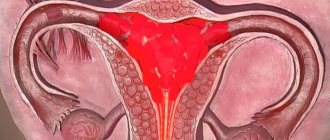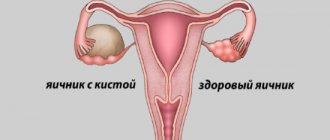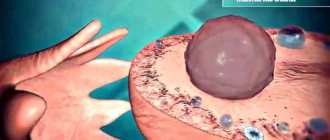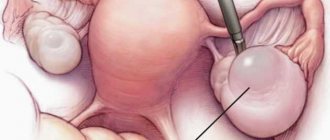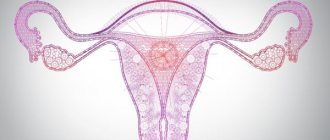An ovarian retention cyst is a disease of the female reproductive system, which is a tumor-like formation. Unlike true tumors, it is not represented by overgrown organ tissue. According to the International Classification of Diseases, Tenth Revision, neoplasm refers to non-inflammatory lesions of the ovary. Codification according to ICD-10 No. 83-2. This is a benign pathology, that is, the retention formation never grows into the surrounding tissues and does not metastasize to other organs.
Ovarian retention cysts are common, which is due to the peculiarities of the female reproductive system. Despite the absence of complaints and symptoms, every girl has a risk of having such a pathology. To diagnose an ovarian tumor and carry out treatment, you should know the features of its formation and development.
Causes of the disease
Ovarian retention cyst is considered a polyetiological pathology, that is, associated with many causes. The greatest role in the formation of the tumor is played by the patient’s hormonal imbalance. An increase in the content of female sex hormones leads to thickening of the mucus secreted by the mucous membrane of the fallopian tubes. As a result, they become clogged, fluid accumulates in them, which then enters the ovary.
Hormonal imbalance is possible for the following reasons:
- stress and nervous tension,
- infectious diseases,
- chronic pathology of internal organs, diseases of the endocrine system (hypothyroidism),
- head injuries,
- obesity or too low body weight, sudden change in weight in a short period of time,
- excessive physical activity, sports,
- procedures performed before IVF.
A retention cyst of the left ovary develops as often as the right one. It is extremely rare for both sides to be affected at the same time. At the moment, it has not been established what the side of the lesion depends on. It is assumed that this is due to the individual characteristics of the woman’s body.
Who is at risk?
This pathology may be associated not only with hormonal imbalance. There are factors in a woman’s life that increase the risk of developing a cyst:
- premature onset of menopause;
- approaching 50 years of age;
- dysfunction of the appendages;
- no pregnancies at all;
- a large number of abortions during reproductive age;
- risk of developing uterine fibroids;
- the transfer of systematic inflammation of the genital organs;
- infectious diseases in the past;
- bleeding.
No sharp changes are observed. The tumor may grow gradually without showing obvious signs. Therefore, a woman should systematically visit a gynecologist in order to identify possible disorders in the early stages.
Also, a woman should pay attention to the nature of vaginal secretion, since changes in it are one of the signs of this disease. We recommend that you read the description of discharge from an ovarian cyst in one of our articles.
Mechanism of retention formations
The ovaries not only produce female sex hormones (estrogens), but also participate in the maturation of eggs. To do this, up to twenty small vesicles called follicles are formed inside the organ every month. As they mature, they increase in volume and their wall becomes thicker. At the same time, estrogen production increases, reaching a peak when the mature follicle approaches the edge of the ovary and ruptures. Then the egg in it is released into the abdominal cavity and then enters the fallopian tube, ovulation occurs.
Retention cysts occur when the process of maturation of the female reproductive cell is disrupted for one reason or another, but the follicle remains intact. Normally, each time a small amount of fluid accumulates in it, which contributes to the rupture of the vesicle and the release of the egg. If the follicle does not rupture, but the contents continue to accumulate, a cyst gradually forms.
A similar development mechanism is typical for other types of retention cavities.
Types of retention ovarian cysts
Depending on the cause of formation, retention cysts are divided into the following types:
- follicular - occurs at the site of the follicle, when it does not rupture and the egg does not exit into the cavity of the fallopian tube,
- corpus luteum cyst – the source of this neoplasm is the corpus luteum, which arises in the ovary and produces the gestagen necessary to maintain pregnancy,
- endometrioid cyst - formed against the background of another gynecological disease - endometriosis. This pathology is associated with the growth of endometrial-like tissue outside the uterine cavity, including inside the ovary. In this case, during menstruation, the size of the cavity increases, and significant pain appears. This condition is dangerous due to the risk of rupture of the membrane and intra-abdominal bleeding,
- paraovarian cyst - with it there is damage to the uterine appendages, that is, a retention neoplasm does not occur in the ovary itself, but in nearby tissues. It differs from other species in its slower growth and long period without symptoms. During the patient’s life, a cyst of this subtype may never bother her at all,
- two-chamber ovarian retention cyst divided into two cavities by a septum. Mainly appears due to a violation of the ratio of male and female sex hormones, endocrine diseases and chronic infectious and inflammatory diseases of the reproductive system. Fluid mixed with blood forms inside the chambers. Most often diagnosed in young women. In practice, doctors also identify multi-chamber formations.
Depending on the type of retention of the ovary a woman has, the clinical picture and the necessary treatment depend.
Is it possible to get pregnant after removal of an ovarian cyst?
The possibility of spontaneous pregnancy is determined by the extent of the operation. With ovarian resection, which involves removing part of the organ, there is no significant loss of fertility. In a unilateral oophorectomy, one ovary is completely removed. The chances of spontaneous conception, although reduced, remain quite high. As a last resort, a woman may be offered to use the services of assisted reproductive technologies, for example, IVF.
After a panhysterectomy there is no chance of pregnancy. But it is worth noting that such operations are performed on postmenopausal women or patients with bilateral ovarian lesions, when other treatment options are not effective, there are risks of malignant transformation, and the patient’s life is at stake.
Possible symptoms of retention neoplasms
If the retention cyst is small in size, it does not manifest itself in any way. In such cases, the disease is diagnosed accidentally during an ultrasound examination for other pathologies. When the diameter of the formation becomes significant, a woman may notice the appearance of unpleasant sensations and discomfort in the abdomen.
As the retention cyst grows, it may manifest itself with the following symptoms:
- menstrual irregularities – there is either an absence of menstruation, or an increase in the volume of blood released, the duration of bleeding,
- bleeding not associated with menstruation
- feeling of heaviness or bloating in the lower abdomen,
- abdominal pain that gets worse with movement,
- discomfort during sexual intercourse.
Retention cystic formation of the right ovary with the development of complications is accompanied by symptoms characteristic of acute intestinal diseases. Appendicitis is often suspected in such patients. This is also facilitated by the fact that when the cyst becomes complicated, symptoms such as vomiting and diarrhea may occur.
If the cavity on the right is large in size, the doctor palpates the abdomen
may detect a large retention formation in the right iliac region. In this case, the patient will complain of pain in the right half of the abdomen. There may also be symptoms of indigestion, such as constipation, that do not go away with the use of laxatives. False urges to defecate may also appear, constantly disturbing the patient.
In the presence of a retention formation of the left ovary, the symptoms differ little from the right-sided lesion. Palpation also reveals an enlarged ovary. If an acute condition develops, the likelihood of a medical error is lower, since its symptoms bear little resemblance to those of appendicitis. In this case, the disease must be distinguished from other acute gynecological pathologies, for example, ovarian apoplexy.
The appearance of a retention cyst of both ovaries is quite rare. In medical practice it occurs in approximately 5-7% of cases.
Diagnostics
To make a diagnosis, the doctor needs to find out the patient’s complaints, history of the development of the disease, and conduct a gynecological and ultrasound examination. The presence of a retention cyst can be suspected if a tumor-like formation is detected in the abdomen during an external gynecological examination. Its dimensions usually vary between 3-5 cm, and it is most often located on the side of the body of the uterus. In some cases, the tumor may be palpated in front of this organ.
An ultrasound examination is required to confirm the pathology. According to its results, a single-chamber cavity filled with homogeneous contents is determined in the ovary. It has a thin, dense wall about two millimeters thick, smooth on the inner surface with no signs of germination of surrounding tissues.
Normally, maturing follicles can be quite large in size and visualized on ultrasound. To distinguish them from retention cystic formations, it is necessary to measure the diameter of the cavity and evaluate the dynamics of its change over the course of the cycle. The pathological process is characterized by dimensions greater than 3 mm and constant presence regardless of the phase of the menstrual cycle.
Dynamic ultrasound allows you to
differential diagnosis between a follicular cyst and cystadenoma - a dangerous malignant disease. This method makes it possible to assess blood circulation in the affected organ and in the tumor. The wall of the cavity has practically no vessels, they do not branch, and do not grow into it. Malignant neoplasms have a good blood supply and a large number of vessels.
Laboratory tests are not used to make a diagnosis. The need for them arises when it is difficult to determine the pathology or when complications develop. For example, they conduct a study of the hormonal profile of the blood, as well as the number of tumor markers.
A retention cystic neoplasm of the left ovary or the same pathology on the right is differentiated with the following conditions and diseases:
- pregnancy,
- inflammatory diseases of the genitourinary system,
- malignant neoplasms.
Correct diagnosis is required to select the optimal treatment and recovery regimen.
How can an ovarian retention cyst be cured?
After determining the pathology, if there is no reason for emergency intervention, the doctor observes the patient for 2-3 months before starting treatment. In some cases, spontaneous healing occurs during this period. If the cyst has not decreased in size, conservative therapy is carried out with hormonal drugs containing gestagen and estrogens (combined contraceptives).
Taking them helps restore the patient’s normal hormonal levels, resulting in a decrease in the diameter of the cyst. To increase the effectiveness of drug therapy, it is necessary to include physiotherapeutic procedures in the list of prescriptions.
In the absence of complications of the ovarian retention cyst, treatment is carried out for 6-8 weeks. The effectiveness of therapy is monitored using regular ultrasound examinations. If there is no improvement in the condition while taking hormonal drugs, or complications develop, surgical intervention is required. Currently, doctors resort to radical measures when the formation is large, without waiting for complications to develop.
The need for radical treatment is also determined by the type of formation. For example, a corpus luteum cyst usually resolves on its own after taking medication. At the same time, a paraovarian neoplasm can only be removed surgically.
The operation is carried out in two ways:
- laparoscopic approach without making a large incision in the anterior abdominal wall. For this purpose, a special device is used, which removes the tumor through punctures,
- laparotomy access is advisable if complications develop, especially if the cause is a right ovarian cyst (to exclude acute appendicitis). Often, when performing such an operation, not only the formation, but also the uterine appendages are removed, since an acute condition is often associated with their damage and further necrosis.
The first method is more preferable, since after such an operation the scars on the skin are practically invisible, and the intervention itself is less traumatic for the patient and does not require long-term pain relief. To perform a laparoscopic intervention, a woman is immersed in anesthesia, after which several incisions about 1 cm long are made on the anterior wall of the abdomen. Manipulators are inserted into them, one of which is a mini-video camera, with which doctors navigate inside the abdominal cavity.
Using laparoscopic instruments, surgeons remove the affected areas of ovarian tissue and remove them. The healthy part of the organ is not damaged, therefore treatment of a retention cyst with this approach allows preserving the patient’s reproductive function. This method is equally effective for cavity resection in both the left and right ovary.
The need for surgical treatment of an ovarian cyst can only be determined based on data from instrumental and laboratory studies. The patient’s condition also plays a significant role in determining treatment tactics - in some cases, hormonal drugs are first prescribed, and after the size of the formation has been reduced, it is drained using laparoscopic access.
Surgery or drug treatment?
Treatment is determined by many factors, which a comprehensive diagnosis will help determine. To determine whether it is possible to do without surgery, you need to clarify:
- menopause (premenopause, menopause or postmenopause);
- type of growth (one-sided or two-sided);
- density of growth on the ovary;
- areas affected by the cyst (one or two ovaries);
- fluid content inside the neoplasm.
If you have an ovarian cyst, you must immediately determine whether it is cancerous or not. If such a formation is benign, it does not need to be removed. First, the woman undergoes a systematic examination three to four times a year so that the doctor can monitor the behavior of the cyst.
If the cyst grows significantly and its appearance changes, the patient is at risk of developing cancer. Here, only the cyst or the entire ovary may be removed. Most often, in oncology, bilateral removal of the uterine appendages is performed. Surgery is also necessary if the woman suffers from constant pain and the cyst is larger than 5 centimeters.
It is worth noting that treatment of ovarian cysts in postmenopause is not based on hormonal drugs. This method remains effective only in premenopause, and after that it is considered pointless. It is also necessary to take into account that quick action and timely diagnosis are very important. Indeed, according to statistics, during menopause the likelihood of developing this pathology increases by almost 20%.
Complications
In some cases, an ovarian retention cyst may be complicated by a condition requiring emergency medical attention. Among the complications of the disease, the main place is occupied by torsion of the leg and rupture of the capsule. Less common is suppuration of the cavity contents.
Torsion of the cyst pedicle
The reasons for the occurrence of this condition are not completely clear, but it often appears when the cavity is large, after a sudden movement. Intestinal motility plays a certain role in the formation of this complication.
When the position of the tumor changes, its pedicle, in which the vessels and nerves supplying it are located, is pinched. As a result, acute ischemia of the retention cyst occurs, which gradually turns into necrosis. Clinically, this is manifested by acute abdominal pain, tension in the abdominal wall, and sharp pain on palpation.
The functioning of the intestines is disrupted; in most cases, bloating and constipation appear. There is often a constant urge to defecate due to intestinal irritation. When listening, intestinal gurgling is not detected.
This condition requires emergency medical attention. If the operation is not performed in time, necrosis of the uterine appendage will begin, followed by the development of peritonitis.
Capsule rupture
This complication is less common, but also requires immediate surgical intervention. It can be caused by injuries, sudden movements, when the retention neoplasm has reached a large size. Rupture of the capsule manifests itself in approximately the same way as torsion of the leg, however, clinical signs arise abruptly, the patient’s general condition worsens faster, and signs of general peritonitis and shock appear.
Treatment of rupture of the capsule of a retention cyst requires a wide opening of the anterior abdominal wall, a thorough examination of the internal organs for the presence of necrosis and other complications. It is impossible to leave the affected appendage of the uterus, as it is a source of infection. The spilled contents are removed, and drainage is left in the abdominal cavity for several days.
Suppuration
This type of complication occurs when a patient has a retention cyst of the right or left ovaries combined with an infectious pathology of the reproductive system. Then the pathogen can get inside the neoplasm and lead to the development of an inflammatory process with the formation of pus.
At the same time, the patient’s body temperature rises and severe abdominal pain occurs. Digestive disorders may also occur, which may include diarrhea, bloating, nausea and vomiting. If a woman does not receive medical care on time, infectious-toxic shock develops - the heart rate increases and blood pressure drops sharply. If medical attention is not given in a timely manner, death is very likely.
Treatment of this condition requires not only surgery, but also the use of antibiotics in large doses. In addition to these measures, it is also necessary to carry out detoxification therapy to cleanse the blood of harmful substances released by pathogenic bacteria.
Treatment Options
Carrying out therapeutic measures involves taking hormonal medications, which are selected based on the results of laboratory and instrumental studies.
In most cases, the specialist prescribes oral contraceptives, the action of which is aimed at stopping the growth of the tumor, reducing its size and preventing the appearance of new lesions. The most popular is Duphaston, which restores the deficiency of its own hormone.
Vitamin therapy is recommended. To stabilize the psycho-emotional background, sedative medications are prescribed. Antibiotics are used to suppress the inflammatory process.
The duration of treatment ranges from several months to a year. If there are no positive results, surgical intervention (laparoscopy or laser therapy) is performed.
For large cystic tumors, it is advisable to use laparotomy. If the tumor is insignificant, partial resection is used.
Illness and pregnancy
Women who have been diagnosed with an ovarian retention cyst before planning a pregnancy often worry about the possibility of conceiving a child. The presence of a small tumor usually does not interfere with the reproductive function of patients. Since the cyst belongs to the group of benign diseases, the cells of its capsule do not grow into healthy ovarian tissue, so new follicles can mature and ovulation occurs.
Reproductive dysfunction occurs when the cyst is large, when compression of the ovarian cortex occurs. As a result, local blood flow is disrupted and gradual cell death begins. If you do not get rid of the tumor in time, then there is a high probability of developing infertility.
It is difficult to predict how an ovarian retention cyst will develop during pregnancy. In this case, the woman’s hormonal background changes, so the neoplasm in many cases decreases in size until it completely dissolves. But sometimes the opposite situation is observed, when it continues to grow and symptoms of the disease appear.
The presence of an enlarged uterus contributes to the development of complications. To avoid this in time, pregnant women need to regularly undergo ultrasound and other diagnostic procedures.
Prevention of formation on the ovaries
The main way to prevent education is to visit a gynecologist at least twice a year. To exclude all factors that allow the development of ovarian cystoma, a woman needs to carefully monitor changes in her body. With menstrual irregularities and infectious diseases, cystoma has a greater chance of developing. Many experts believe that the key to women's health is regular sex life. However, you should take the selection of contraceptive methods seriously and avoid abortion.
According to statistics, women who have given birth are less likely to suffer from ovarian cystoma, so it is advisable to realize childbearing function before the age of 35.
Do not forget about a healthy lifestyle and proper nutrition, which maintains the level of immunity. Your diet should definitely contain selenium, vitamin A and as little animal fat as possible.

